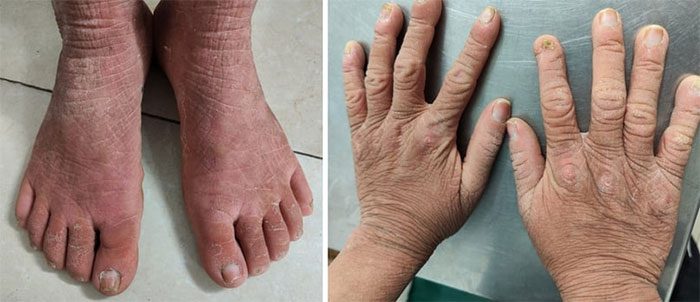A 31-year-old woman with dry skin, widespread keratosis, and hair loss, including eyebrows and eyelashes, has been diagnosed with Keratitis-Ichthyosis-Deafness (K.I.D) syndrome, a rare condition with only around 100 documented cases worldwide.
She is the second child in a family of four siblings; her parents are not closely related by blood, and no one in the family has shown similar symptoms. The condition began right after birth, presenting as a membrane around her body, followed by dry skin and scattered scaling all over.
Over time, the patient’s skin lesions became significantly drier, with some areas developing pronounced keratosis, particularly forming large scaly patches on the scalp, knees, and lower legs. She experienced diffuse hair loss on her head, with sparse eyebrows and eyelashes. Her fingernails and toenails exhibited yellowing, with some digits showing keratinization beneath the nails. The patient also displayed reduced sweating and mild developmental delays; she is completely deaf from birth, leading to mutism and corneal opacity in her eyes.
Dr. Nguyễn Thị Thảo Nhi from the Women and Children’s Dermatology Department at the Central Dermatology Hospital stated that after one week of treatment for Keratitis-Ichthyosis-Deafness (K.I.D) syndrome with medication, the patient’s skin lesions became less dry, and the thickened patches on her scalp and lower legs began to peel, leaving a red base.

Patient with yellow nail lesions, keratinization beneath the nails. (Image: Hospital provided).
K.I.D syndrome was first described in 1915. To date, approximately 100 cases of this syndrome have been reported in the global medical literature. This is a rare genetic disorder that leads to abnormal skin issues, eye abnormalities, and hearing loss.
Skin abnormalities include palmoplantar keratoderma, generalized keratosis, nail dystrophy, hair loss, and fish-scale-like skin peeling. Eye issues are characterized by keratitis with corneal neovascularization, which can cause pain and light sensitivity, and in severe cases, may lead to blindness. Symptoms can begin in infancy and progressively worsen with age.
Cases of K.I.D syndrome are mostly sporadic, with the global literature documenting occurrences in both recessive and dominant inheritance. The condition is genetically heterogeneous, caused by point mutations in the GJB2 gene, which encodes for Connexin 26 protein, located on chromosome 13q12.
Treatment for K.I.D syndrome includes keratolytic agents, topical moisturizers, and in some cases, retinoids, antibiotics, and antifungal medications may be prescribed. Lubricants and anti-inflammatory treatments can be used to alleviate eye symptoms. Some patients may undergo cochlear implantation to restore hearing.


















































